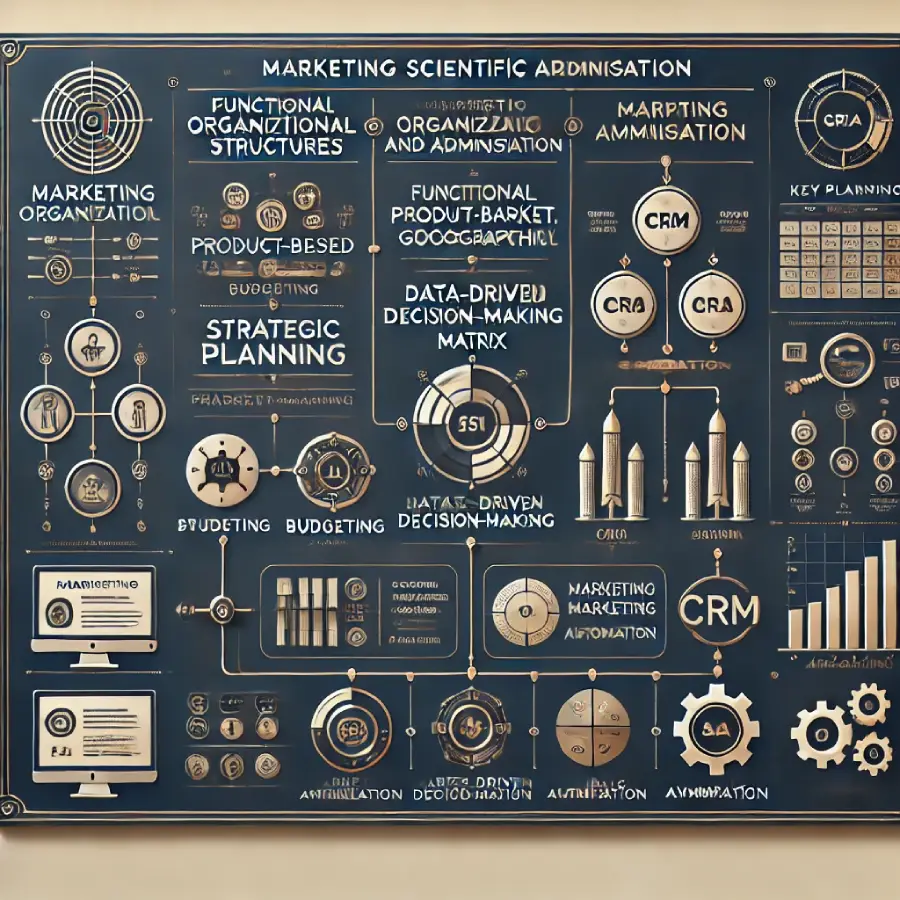Abstract
Marketing as a discipline has evolved from a traditional sales-driven approach to a scientifically structured and strategically administered function within organizations. Marketing scientific organization and administration involve the systematic application of research, data-driven decision-making, and structured planning to achieve marketing objectives efficiently. This article explores the fundamental principles, components, and best practices of marketing scientific organization and administration, emphasizing its role in optimizing performance, resource allocation, and long-term success.
1. Introduction
Marketing is no longer just an art; it is increasingly recognized as a science that requires methodical organization and administration to ensure effectiveness. With the rise of data analytics, behavioral psychology, artificial intelligence (AI), and strategic planning, marketing has become a highly structured function within businesses. A well-organized marketing department enables companies to align their objectives, coordinate various marketing activities, and maximize return on investment (ROI).
This article provides an in-depth analysis of marketing scientific organization and administration, detailing how companies can structure their marketing departments, implement research-based decision-making, and integrate technological advancements to enhance efficiency.
2. Key Components of Marketing Scientific Organization and Administration
2.1. Marketing Scientific Organization
Marketing scientific organization refers to the structured and systematic approach to planning, executing, and managing marketing functions. It involves defining roles, optimizing workflows, and ensuring efficient collaboration between different teams.
Types of Marketing Organizational Structures:
- Functional Structure:
- Organized based on marketing functions such as advertising, market research, digital marketing, sales promotion, and customer service.
- Example: A retail company with separate teams handling SEO, PPC advertising, and social media marketing.
- Product-Based Structure:
- Marketing teams are divided based on different product lines or categories.
- Example: Apple has separate marketing teams for iPhones, MacBooks, and iPads.
- Market/Segment-Based Structure:
- Teams focus on specific customer segments or industries.
- Example: A B2B software firm has different teams for enterprise clients, small businesses, and government agencies.
- Geographical Structure:
- Marketing teams are organized based on geographic regions to cater to local market preferences.
- Example: Coca-Cola has marketing teams for North America, Europe, and Asia-Pacific.
- Matrix Structure:
- Combines two or more structures (e.g., functional and geographical) for greater flexibility.
- Example: A multinational corporation that manages digital marketing globally but tailors campaigns to local markets.
2.2. Marketing Administration
Marketing administration involves the processes, policies, and strategies that ensure effective implementation and control of marketing activities.
Key Aspects of Marketing Administration:
- Strategic Planning:
- Developing long-term marketing goals aligned with business objectives.
- Example: A five-year digital transformation plan to shift from traditional to AI-driven marketing.
- Budgeting and Resource Allocation:
- Optimizing financial and human resources for maximum marketing effectiveness.
- Example: Allocating 40% of the marketing budget to social media campaigns based on ROI analysis.
- Data-Driven Decision-Making:
- Using analytics and market research to guide marketing strategies.
- Example: Leveraging consumer behavior insights to personalize product recommendations.
- Campaign Execution and Monitoring:
- Implementing, tracking, and adjusting marketing campaigns for effectiveness.
- Example: A/B testing email subject lines to optimize open rates.
- Performance Measurement (KPIs & Metrics):
- Establishing and analyzing key performance indicators (KPIs) such as customer acquisition cost (CAC), return on ad spend (ROAS), and conversion rates.
- Example: Tracking monthly lead generation growth through Google Analytics.
- Compliance and Ethical Considerations:
- Ensuring marketing practices adhere to legal, ethical, and industry standards.
- Example: Complying with GDPR in email marketing campaigns.
3. The Role of Technology in Marketing Organization and Administration
Technology plays a pivotal role in modern marketing, enabling greater efficiency, automation, and data-driven decision-making.
3.1. Marketing Automation
- Platforms like HubSpot, Marketo, and Salesforce streamline workflows by automating email marketing, customer segmentation, and lead nurturing.
3.2. Artificial Intelligence and Machine Learning
- AI-driven tools like Google’s Predictive Search and IBM Watson Marketing optimize campaign personalization and customer insights.
3.3. Customer Relationship Management (CRM)
- CRM systems like Salesforce, Zoho, and Microsoft Dynamics centralize customer data to enhance engagement and retention.
3.4. Marketing Analytics
- Google Analytics, Tableau, and SEMrush provide real-time insights into customer behavior, website performance, and ad effectiveness.
4. Benefits of Marketing Scientific Organization and Administration
A structured marketing approach leads to several competitive advantages:
- Enhanced Efficiency and Productivity
- Clear roles and responsibilities prevent duplication of effort and optimize workflow.
- Improved Customer Engagement and Experience
- Data-driven insights allow for hyper-personalized marketing strategies.
- Greater ROI and Cost Optimization
- Strategic budgeting ensures resources are allocated effectively.
- Stronger Brand Positioning
- Cohesive marketing efforts reinforce brand consistency and differentiation.
- Adaptability and Innovation
- A well-administered marketing structure allows companies to pivot quickly in response to market trends.
5. Challenges and Solutions in Marketing Organization and Administration
Despite its benefits, companies face challenges when structuring and managing marketing functions.
| Challenge | Solution |
|---|---|
| Siloed Departments | Foster interdepartmental collaboration through integrated platforms. |
| Over-Reliance on Data | Balance data-driven insights with creativity and intuition. |
| Changing Consumer Trends | Implement agile marketing strategies for quick adaptation. |
| Budget Constraints | Use ROI analysis to optimize marketing spend. |
6. Case Studies
6.1. Amazon: Data-Driven Marketing Administration
Amazon’s marketing success is built on a scientifically structured approach:
- Customer data integration for personalized recommendations.
- AI-driven marketing automation for efficiency.
- Cross-functional teams ensuring seamless execution of global campaigns.
6.2. Procter & Gamble: Market-Oriented Organizational Structure
P&G uses a hybrid structure:
- Product-based teams for brand management.
- Geographical divisions to address local market needs.
- Advanced analytics to optimize consumer engagement.
7. Conclusion
Marketing scientific organization and administration are essential for businesses seeking efficiency, consistency, and competitive advantage. A well-structured marketing function, combined with strategic planning, data-driven decision-making, and technological integration, ensures that organizations can navigate complex markets and deliver meaningful customer experiences.
As marketing continues to evolve, businesses must prioritize cross-functional collaboration, digital transformation, and adaptive strategies to remain competitive in the global marketplace.
8. References
- Kotler, P., & Keller, K. L. (2016). Marketing Management (15th Edition). Pearson.
- McKinsey & Company (2023). The Future of Marketing Organization and Strategy.
- American Marketing Association (AMA). Best Practices in Marketing Administration.
- Harvard Business Review (2022). Data-Driven Marketing Structures for Competitive Advantage.
- HubSpot Research (2023). How Marketing Automation is Transforming Business Strategies.

